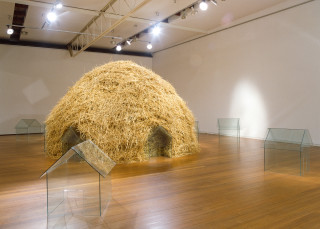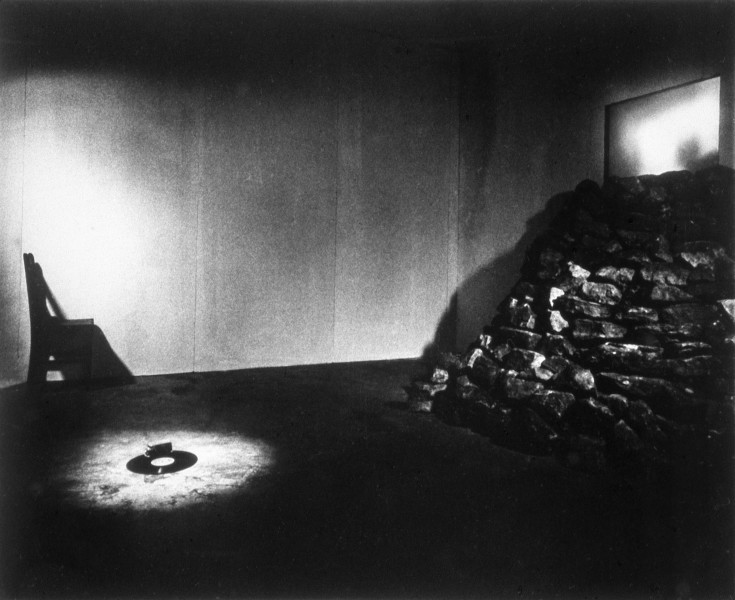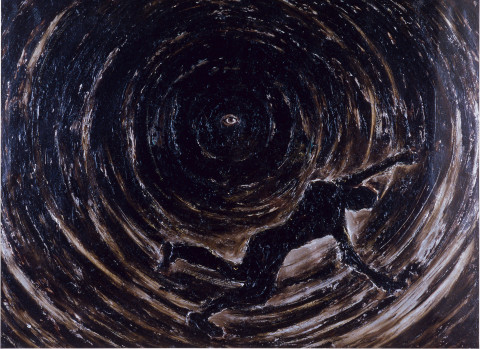Ken Unsworth's first solo exhibition at Roslyn Oxley9 Gallery.
Exhibition Dates: 27 March – 14 April 1984
The great Russian critic, Viktor Shklovsky, once described Laurence Sterne's Tristram Shandy as 'the most typical novel in world literature'. Those who have read Sterne (but not Shklovsky) may find it puzzling to see this most eccentric of novels described as 'typical'. But what Shklovsky was driving at was that this novel exemplified the kinds of qualities which Shklovsky
associated with good art. Paradoxically, those novels which we usually regard as 'typical' actually exemplify only a debased and essentially uninteresting art.
For Shklovsky the primary function of art was to make us look at the world with fresh eyes, as though for the first time. Accordingly, many of the devices of a work of art will be contrived to throw into question our perceptual habits so that when we look at the world we see it not as we know it to be (as it is familiar to us), but as our senses deliver it to us, as we really see it. Tristram Shandy, of course, is all contrivance. Sterne never allows us to take the book for granted or to read it as we have become used to reading more 'typical' books. The devices of the novelist are continually exposed, in the same way that Brecht demanded that the illusion-creating devices of the theatre be exposed in order that the audience approach the play free from assumptions.
By using the word 'typical' so ambiguously Shklovsky is, of course, practising what he preaches because he prevents us assuming a meaning for the word and forces us instead to re-assess
both the word itself and the novel which he denotes as being so typical.
It seems to me that Ken Unsworth is 'typical' in both of Shklovsky's senses of the word. Let me take the most obvious aspect of this typicality first.
Unsworth's journey as an artist is almost a paradigm of what Rosalind Krauss termed the 'passages' in modern sculpture. He began as a painter, producing paintings which were semi-abstract,
expressive and sensual. Their main interest today lies in the fact that we detect the same sensibility which is present in Unsworth's current work.
Eventually, Unsworth realised that the visual problems which appealed to him were best dealt with in three dimensions rather than two. At first he worked in collage, but quickly moved on to making pieces of free-standing sculpture.
Initially, the sculptures were effectively three-dimensional renderings of the subjects of his paintings. Soon, however, he began producing pieces (both as maquettes and at full scale) which were to prove characteristic. Broadly, the sculptures were of two kinds: highly formal, minimal sculptures fabricated from welded steel, and pieces (predominantly as maquettes) made from natural, found materials.
This dichotomy typifies Unsworth's output as much as it parallels the duality of modern sculpture generally. The dichotomy is this: on the one hand, a preoccupation with essential forms and with the traditional values of Western artmaking (that is, reflecting on or questioning traditional art practices); on the other hand, an attraction to the natural environment and creating aesthetic experiences by directing the viewer's attention to what already exists rather than by artifice - and doing this simply by acts of selection and arrangement rather than by actually 'making' something in the traditional sense.
There is not space here to elaborate much further on these themes in contemporary Western sculpture. But it may be useful to note that this dichotomy which Unsworth so typifies can also be understood as two opposing ideological strands in modern art.
The so-called modernist strand, for example, represents a kind of purifying impluse, best articulated by critics such as Roger Fry and Clement Greenberg. This impulse grows out of a conviction that any art form should always endeavour to identify for itself a unique function which nothing else could fulfill. Having identified such a function, the art form should focus on that and try to
eliminate any elements which are extrinsic to it. Abstraction, for example, is the product of such an impulse holding that the ideational and emotional content of representational art is not intrinsic or unique to painting or sculpture and should, therefore, be eliminated.
The modernist aesthetic, therefore, is a kind of narrowing activity which seeks to delimit the categories open to the visual arts.
The alternative strand in modern art is, by contrast, eclectic. It seeks to broaden the categories of visual art. This strand of contemporary art-making has continually explored new possibilities, developed new modes and materials for making art. Conceptual art and its derivatives were examples from this strand which promoted the idea that an object was not essential to art; art was not material, but experience and concepts.
Out of the gestures of conceptual art came the notion that art could also consist, not just of objects, but also of actions; that it didn't have to sit statically on the floor or on the wall, but could occupy entire spaces as well as occupying time itself in the sense of being a performance or, indeed, an object which was programmed to dematerialise and therefore having a duration. It followed that the artist himself could be both the subject and the materials of his art. Again, from this point of view, the object was regarded as an unnecessary mediation between the artist and his audience.
The last ten years of Ken Unsworth's work has explored both these options. On the one hand, he has taken on purely formal issues in sculpture balance, volume in space, illusions of movement and anti-gravity. The most recent, the most public and best known of these works is Nike which stands outside the Wollongong Art Gallery in N.S.W., Australia - a piece which is not only artistically successful, but also a great popular success with the image appearing now on Council letterheads and once touted as the emblem for the local football team.
On the other hand, and to an increasing extent, Unsworth has been preoccupied with discovering new expressive means outside the traditional materials of sculpture. His abandonment of traditional sculptural practices has not been mere whimsy, but has grown out of a real need - the need for the expression of and resolution of private and intense ethical concerns. The dramatic installations which he has been executing since 1975 (some recent ones being, "Go and don't look back ", "Rhythms of childhood' and "The waiting room') have parallels with Samuel Beckett's late plays, described by Martin Esslin as 'densely concentrated images of human existence'.
For Ken Unsworth life comes very much before art. Art's job is to try to unravel the tangled feelings which are the legacy of our life experiences.
The works in the current exhibition clearly belong to the 'eclectic' part of Unsworth's output. This applies equally to the drawings as it does to the two installations. His drawings belong in the category of neo-expressive art which has revived an interest in painting and drawing - a revival, it seems to me, which has its origins in conceptualism rather than in any re-examination of the formal and aesthetic features of drawing and painting as we have traditionally known them. In other words, neoexpressive art is all about content, and nothing to do with form - and the content is substantially to do with the self, its fears, its repressions, its formative characteristics. In the case of Unsworth, both the drawings and the installations are highly personal creations and are not easily decodable.
In fact, it is important that we don't expect our experience of installations such as "The forest of wistful thoughts" and "Memories of childhood" to be entirely rational or open to verbal explication. They are not conceived that way. Their objective is to lead us beyond the rational and to an experience of life as a mystery, mediated by those myths and images which have traditionally (or as purely private mythologies) served to help us cope with the seeming absurdities of human existence.
And perhaps it is in this sense that Ken Unsworth is a 'typical' artist. This difficulty in his work, this resistance to rational explanation and verbal translation makes his work typical of what we expect art to be. In an important sense all good art is literal. It must be taken at face value. Unfortunately, we usually find it very difficult to do so. We feel compelled to ask: "But what does it mean?" - implying, of course, that a work of art must be susceptible to translation into words.
Perhaps, however, the meaning of a work of art consists in the experience of it rather than in the translation of it. The way it presents itself to us as an object of perception is what the work of art is all about. To try to go beyond that and start imposing 'explanations' is to miss the point.
Unsworth's installations are difficult because life itself is difficult. It is not readily explained. The images, the memories, our experiences in life do not normally fit together into neat structures of meaning. More often we go to the grave with our feelings and life experiences unresolved into anything resembling a rational picture, neatly framed at the edges.
Unsworth's installations are highly condensed dramatic images, themselves clusters of discrete,seemingly unrelated images. Each of the discrete images the chair which dementedly crashes from one wall to another in "Memories of childhood", or the faulty record, the pile of stones which bar passage to the ethereal room beyond - suggests a meaning but defies comprehensive explanation. More dominant are the emotions evoked by the objects and sounds - half-remembered, perhaps long-repressed, attenuated fingers probing back into a part of our self and its history. The installations are an attempt to make sense of it all and to be at the same time a record of that endeavour - an endeavour which by its very nature must always remain unsatisfactory.
In our lives we carry forward with us an emotional resonance of all that has happened to us (some say starting in the womb - R.D. Laing, for example). We sense that it has some significance. Indeed, we desperately hope that it does. But we cannot put that significance into words.
The impact of Ken Unsworth's installations should be emotional, not rational. Any rationality they may have must perforce come later, after we have left the exhibition, as our feelings begin to sort themselves out. As a 'typical' artist, Unsworth ought to peel back the layers of habit from over our eyes and feelings and have us see and hear as though again for the first time.
Paul McGillick
 Group Show, Stockroom
Group Show, Stockroom
Roslyn Oxley9 Gallery, 1995
 Ken Unsworth Good thoughts
Ken Unsworth Good thoughts
Roslyn Oxley9 Gallery, 1995
 Ken Unsworth Everlastingness
Ken Unsworth Everlastingness
Roslyn Oxley9 Gallery, 1994
 Group Show
Group Show
Roslyn Oxley9 Gallery, 1992
 Ken Unsworth Mixed feelings
Ken Unsworth Mixed feelings
Roslyn Oxley9 Gallery, 1991
 Group Show
Group Show
Roslyn Oxley9 Gallery, 1990
 Group Show, The Cocktail Party (All Gallery Artists)
Group Show, The Cocktail Party (All Gallery Artists)
Roslyn Oxley9 Gallery, 1988
 Ken Unsworth
Ken Unsworth
Roslyn Oxley9 Gallery, 1988
 Group Show, 7th Biennale of Sydney
Group Show, 7th Biennale of Sydney
Roslyn Oxley9 Gallery, 1988
 Ken Unsworth Drawings from Germany
Ken Unsworth Drawings from Germany
Roslyn Oxley9 Gallery, 1987
 Group Show, The Forbidden Object
Group Show, The Forbidden Object
Roslyn Oxley9 Gallery, 1986
 Ken Unsworth Recent painting and sculpture
Ken Unsworth Recent painting and sculpture
Roslyn Oxley9 Gallery, 1985
 Ken Unsworth Three recent installations
Ken Unsworth Three recent installations
Roslyn Oxley9 Gallery, 1984





